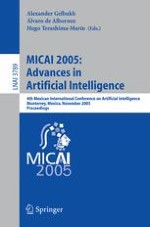2005 | Buch
MICAI 2005: Advances in Artificial Intelligence
4th Mexican International Conference on Artificial Intelligence, Monterrey, Mexico, November 14-18, 2005. Proceedings
herausgegeben von: Alexander Gelbukh, Álvaro de Albornoz, Hugo Terashima-Marín
Verlag: Springer Berlin Heidelberg
Buchreihe : Lecture Notes in Computer Science
